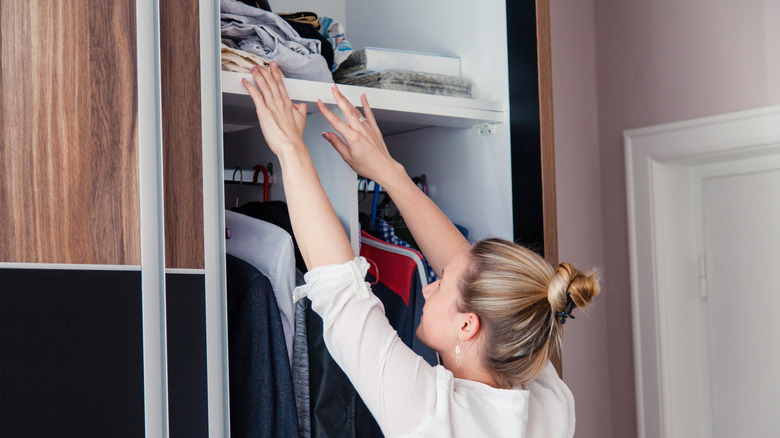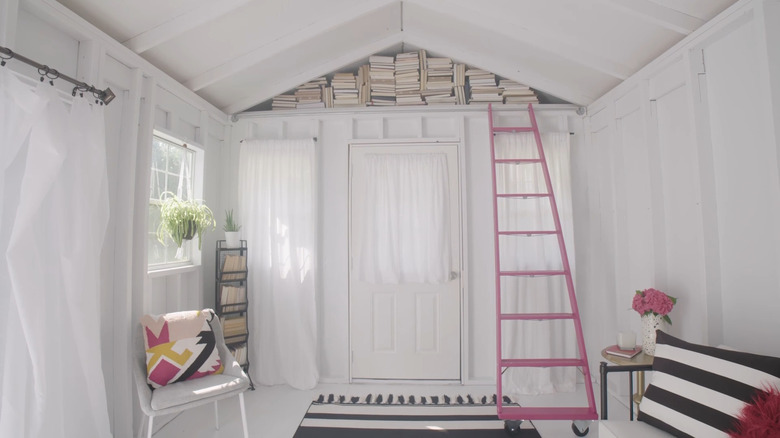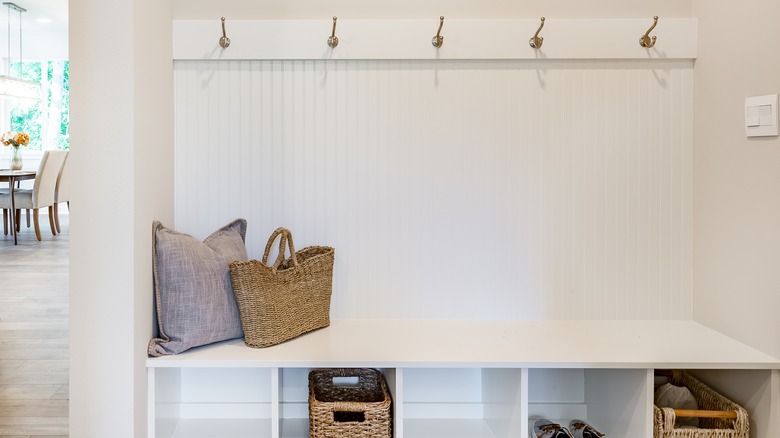The Genius Way HGTV's Jenn Todryk Uses A Ladder To Create A Functional Closet
Over time, many of us obtain more and more things, and that can make it difficult to keep our lives organized and functioning in the most efficient way. An example of this was shown on HGTV's "No Demo Reno," where a homeowner had a closet that was packed to the brim and difficult to use. In Episode 8 of Season 2, this atypical project challenged Jenn Todryk. "I think my biggest challenge here, honestly, is how creative can I get with a closet as far as 'design,'" Todryk says after the initial meeting. However, Todryk notices that the couple isn't using the top shelves or the space between the top of the closet units and the ceiling. To combat this wasted space, the designer adds shelving and a sliding ladder to reach it.
Though there were some questions about how creative she could get, Todryk made a closet that was functional and aesthetically pleasing in a way that most people wouldn't think about. When it comes to storage solutions, utilizing as much space as possible as smartly as possible is essential. Many people forget to use vertical space because of the challenges with height. High shelves are often inaccessible, making retrieving items from them a hassle. However, not using the space between standard shelves or cabinets and the ceiling can be a waste. Adding a ladder to reach it is a smart way to use all your available space.
Go up when possible
For many people determining how large a room is, they look at the square footage. This is a great place to start since it can tell you the size of the furniture and the potential placement of those items. However, square footage is the total floor area and doesn't account for the height of the room. Essentially, square footage tells you how much horizontal floor space you have but not how much vertical space a room has.
The closet that Jenn Todryk redesigned for her clients was blessed with high ceilings that they weren't taking advantage of. "They do not use the top shelving at all," Todryl explains in the episode, "so let's put in more long shelves, and that way, they can store seasonal products and more shoes. I want there to be a ladder with a fancy railing system." Using this vertical space instantly made the closet much more functional. Installing the shelves in the unused area below the ceiling provided more surfaces that helped organize and unclutter the original space.
Though Todryk remodeled a closet, this method can be used throughout the home to utilize vertical space, such as in a kitchen or living room. There are library ladder kits, such as from Stairway Shop, that homeowners can easily install in their own spaces. With a variety of styles and hardware, their kits range from $716.10 to $5,215.95, depending on finish, height, and other customizations.
Vertical storage throughout the home
Utilizing your vertical space isn't only an idea to organize a small closet; it can be applied anywhere in your home to provide smart storage. Vertical space storage is especially useful for small homes or to keep a floor plan from feeling too cluttered. You can apply Jenn Todryk's idea of floor-to-ceiling storage with a library ladder nearly anywhere in the home. In the kitchen, you can opt for cabinets that reach the ceiling and store items you only use occasionally on the top shelf. Then, install a library ladder that can reach those items and slide out of the way when not in use. Similarly, you can use this method for a pantry to store food, in a living room to store books, games, or DVDs, or in an office to store important files. You can even make use of vertical space in your laundry room.
Another way to use vertical space is to utilize areas that are often left empty, such as the space above doorways. This is a great area to add a floating shelf to place décor and miscellaneous items like plants, books, and decorative objects. Of course, using vertical space doesn't always mean adding a shelf. You can take advantage of wall space with hooks, pegboards, and wall-mounted bars. These can store small items like jewelry or purses in a bedroom or closet, keys or coats in an entryway, or pans in a kitchen.



